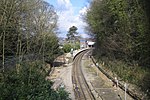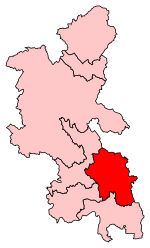The Chesham branch is a single-track railway branch line in Buckinghamshire, England, owned and operated by the London Underground. It runs from a junction at Chalfont & Latimer station on the Metropolitan line for 3.89 miles (6.26 km) northwest to Chesham. The line was built as part of Edward Watkin's scheme to turn his Metropolitan Railway (MR) into a direct rail route between London and Manchester, and it was envisaged initially that a station outside Chesham would be an intermediate stop on a through route running north to connect with the London and North Western Railway (LNWR). Deteriorating relations between the MR and LNWR led to the MR instead expanding to the northwest via Aylesbury, and the scheme to connect with the LNWR was abandoned. By this time much of the land needed for the section of line as far as Chesham had been bought. As Chesham was at the time the only significant town near the MR's new route, it was decided to build the route only as far as Chesham, and to complete the connection with the LNWR at a future date if it proved desirable. Local residents were unhappy at the proposed station site outside Chesham, and a public subscription raised the necessary additional funds to extend the railway into the centre of the town. The Chesham branch opened in 1889.
While construction of the Chesham line was underway, the Metropolitan Railway was also expanding to the northwest, and in 1892 the extension to Aylesbury and on to Verney Junction opened. Most trains on the branch line were operating as a shuttle service between Chesham and the main line at Little Chalfont rather than as through trains to London. The opening in 1899 of the Great Central Railway at Marylebone station, Edward Watkin's connection between London and Manchester, as well as the highly successful Metro-land campaign encouraging Londoners to move to the rural areas served by the railway, led to an increase in traffic in the area, although the Chesham branch was less affected by development than most other areas served by the railway. In 1933 the Metropolitan Railway was taken into public ownership and became the Metropolitan line of the London Underground. London Underground aimed to concentrate on their core business of passenger transport in London, and saw the rural and freight lines in Buckinghamshire as an expensive anomaly. The day-to-day operation of the Chesham branch was transferred to the London and North Eastern Railway, although London Transport retained control. In 1960 the line was electrified, and from 1962 on was operated by London Underground A Stock trains.
In the 1970s and 1980s decaying infrastructure and the withdrawal of subsidies brought the future of the line into doubt. As one of its last acts the Greater London Council paid for the replacement of two bridges on the line, allowing operations to continue. The centenary of the line in 1989 saw a renewal of interest and an upgrading of the trains between London Marylebone station and Chalfont & Latimer made commuting more practical, and usage of the line stabilised. The introduction of London Underground S Stock in 2010 led to the replacement of the shuttle service with half-hourly through trains to and from London.









